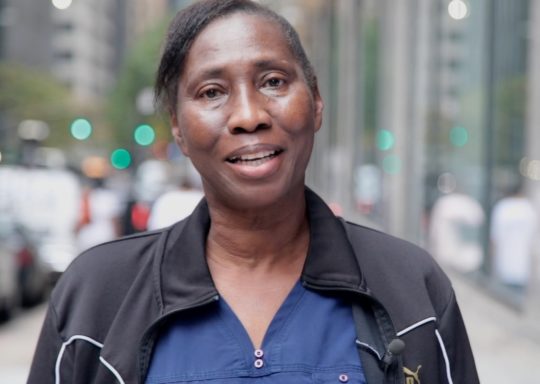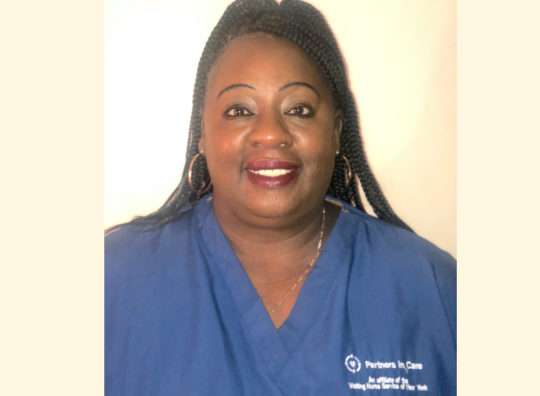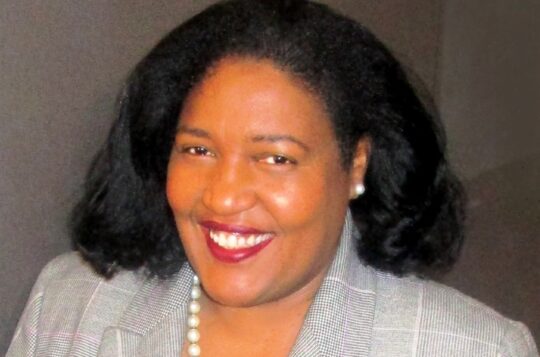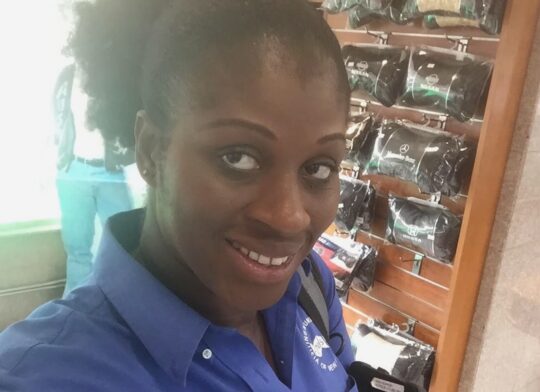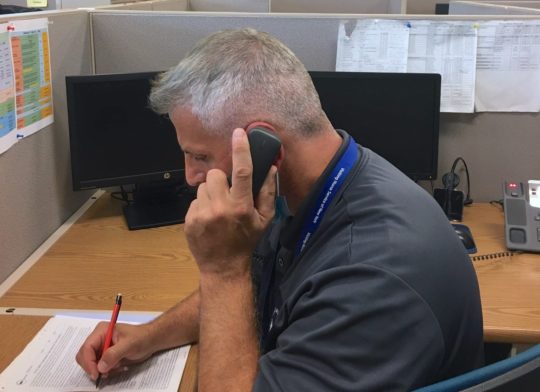VNSNY Heroes of 2020
“We Are All Heroes!” Don’t Miss this Hometown Heroes Parade Video!
July 13, 2021–On July 7th, VNSNY staff representing all parts of the organization marched through the Canyon of Heroes in lower Manhattan, in a historic parade celebrating the contributions of all essential workers throughout the Covid-19 pandemic. Health care employees, transportation workers, food service professionals, and other groups gathered together to participate in what is now being called one of the largest ticker tape parades in the city’s history. Starting at Battery Park, VNSNY made their way up Broadway to City Hall, meeting with press, government officials, and countless grateful New Yorkers along the way. See for yourself! Click below to watch the moving video, and thanks to everyone who marched for representing VNSNY! The following are the VNSNY Heroes who participated in the parade: Partners in Care: Denise Mallette, Home Health Aide, Yeasmin Mehli, Home Health Aide, Elvira Ruiz, Home Health Aide, Veronica Ventura, Home Health Aide— CHHA: Eileen Baez, Registered
Related Articles
Breaking Video and Photos from Today’s Hometown Heroes Parade!
July 7, 2021–Breaking news! U.S. Senator Chuck Schumer meets up with the VNSNY heroes who are representing VNSNY at today’s Hometown Heroes Parade! Watch the video here below and see photos of today’s event as it unfolds. VNSNY Marching! And another marching video! Here are the photos!
Don’t Miss This Inspiring Video Celebrating Partners in Care Home Health Aide Heroes!
December 16, 2020–On Monday evening, December 14th, VNSNY Partners in Care held its annual Service Awards program. This virtual event celebrated nearly 800 Partners in Care staff members and included an inspiring video spotlighting on 14 Partners in Care home health aide heroes and their passion for the important work they do. To watch this video, please click below.
“Caring, Knowledgeable and Engaged”: How a Fast-Acting Partners in Care Team Helped a 101-Year-Old Patient Recover Safely at Home
October 16, 2020–“It is difficult to express how grateful we are for the extraordinary service we received from Partners in Care,” wrote the niece of a 101-year-old man in Queens in a recent e-mail to Andria Castellanos, VNSNY’s Executive Vice President and Chief of Provider Services. The story had begun a week earlier, with what the niece called “a family emergency.” Her uncle, recovering from pneumonia and electrolyte imbalance, but coherent and in good spirits, had been released on a Friday night from the hospital to a rehab facility. “By Saturday morning, after a terrible night alone, he was disoriented and refused to eat,” his niece recalled. “We also learned that, due to COVID-19, not only could his wife not come over that day, but he would be unable to have any visitors at all for over a week.” The family realized that, for his mental, emotional—and, ultimately, physical—health, he needed to
Returning to the Front Lines After Recovering from COVID-19
October 9, 2020–Even though COVID-19 made her feel “like I was dying here in my apartment,” home health aide Arcina Batista’s faith, her determination born of a strong mother, and her commitment to her Partners in Care clients all helped her get through the illness and return to work. It wasn’t easy: Arcina had a high fever for weeks, lost a lot of weight, and felt thoroughly weak and exhausted—but she kept her focus on recovering. “I said to myself, I have to do it. Everything is possible when you put your mind to it,” she says. Arcina’s 89-year-old mother, who lives a block away and communicated with her by video calls, supported her in the fight. “You are going to make it,” she told her daughter. Arcina wanted to get better for her mother, her two daughters, her husband—and her clients, elderly New Yorkers who are often isolated and suffering. “My
For Lauren Campbell, Weathering Storms Is All in a Day’s Work
September 24, 2020–Every day, VNSNY’s staff serves as a lifeline for vulnerable New Yorkers in their homes and communities, knocking on doors or conducting telehealth visits to provide care and connection. That lifeline is all the more critical in times of emergency, when pandemics, storms, power outages and the like threaten to cut our patients and plan members off from much-needed care. Long before those knocks on doors or telehealth visits take place, however, the VNSNY Emergency Response team is hard at work making sure that our staff is prepared and that the right people have the right resources, support and knowledge in the right place at the right time to deliver the right care to those who need it. “Our Emergency Response team pulls expertise from those staff members who are most knowledgeable about the organization,” says Lauren Campbell, Emergency Response Systems Manager. The team follows the Federal Emergency Management Agency’s
VNSNY Nurse Nana Asamoah: Managing Patients’ Medications During the Pandemic—and Beyond
September 13, 2020–Even before the COVID-19 pandemic, medication management was a struggle for many people. Research shows that nearly 3 out 4 Americans don’t take their medications as directed in the best of times, and 1 in 3 never even bother to fill their prescriptions. The complications of COVID-19 have made this bad situation even worse: Many pharmacies and doctor’s offices were closed for a time, and even today many still have reduced hours or are difficult to reach, with limited deliveries. At the same time, people are quarantined at home and unwilling to go out, and family members and other caregivers are staying away because of social distancing. On top of that, many patients have new medication regimens to treat the coronavirus itself. As a nurse with VNSNY Home Care’s Manhattan Branch 6, Nana Asamoah sees such scenarios on a regular basis. When she reconciles a new patient’s medications as part
Social Worker Joseph Alvino on How “Connecting with Others Can Really Help”
September 1, 2020–During the April peak of the COVID-19 pandemic in New York City, social worker Joseph Alvino was sick with COVID-19 himself—“I had every symptom in the book,” he says—and was also mourning the loss of his father from the illness. But Joe, who has been with VNSNY for over 25 years, opted to continue visiting patients by telephone, per COVID-19 protocols, a heroic act that gave him purpose and provided patients with a compassionate and expert resource. “It was important for me to keep my mind busy and active, doing the best I could to help my patients with all they’re dealing with,” says Joe. A full-time social worker with VNSNY Home Care’s Queens Branch 1, Joe cares for patients coping with a variety of medical conditions and for their often-overburdened family caregivers. During that April peak, at a time when even the simple act of going to the grocery
The Partners in Care Education Department: Training the Front Lines in Challenging Times
August 27, 2020–Home health aides are invaluable. They’re the boots on the ground for providing assistance with activities of daily living to patients and plan members, and they’ve never been more needed than during these critical pandemic times. The Partners in Care Education Department provides the thorough instruction and support that ensures that all Partners in Care home health aides have the necessary skills to care for their patients. “The department goes beyond the New York State Department of Health’s education requirements,” says physical therapist Sonia Rapaport, a Rehabilitation Instructor with Partners in Care. “No matter what pops up—from Ebola to COVID-19—the Education Department has always been there. Everybody jumps as high as they need to jump to get all the HHAs caught up as quickly as possible.” These days, they’ve never had to jump higher. The huge challenge with COVID, of course, has been that training has to turn on a
VNSNY Employee Support Calls Provide Comfort and Social Connection
August 19, 2020–When VNSNY began doing telephone support calls for employees during the coronavirus pandemic’s spring peak, Amanda Weiner, VNSNY Organizational Development Specialist, recalls how moving it was to see such widespread and immediate response to the support. “We had 168 people phone in to the first call for Partners in Care home health aides, then 178 for the second—so we knew we were on to something right away,” she says. Amanda, who has been with VNSNY 15 years, teamed up with VNSNY Hospice Lead Social Worker Ben Cirlin to organize the emotional support calls—several of which Ben hosts himself. “I hope it reduces the stigma for people around asking for help,” she notes. “The powerful words I’ve heard from our committed staff will never leave me.” The earliest support calls were area-specific, including calls tailored to home health aides, and CHHA managers and field staff. Then it became apparent that open-staff


